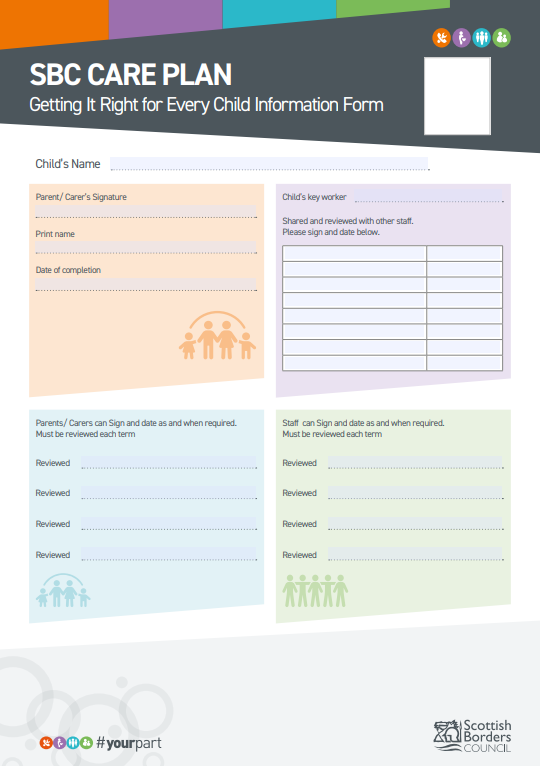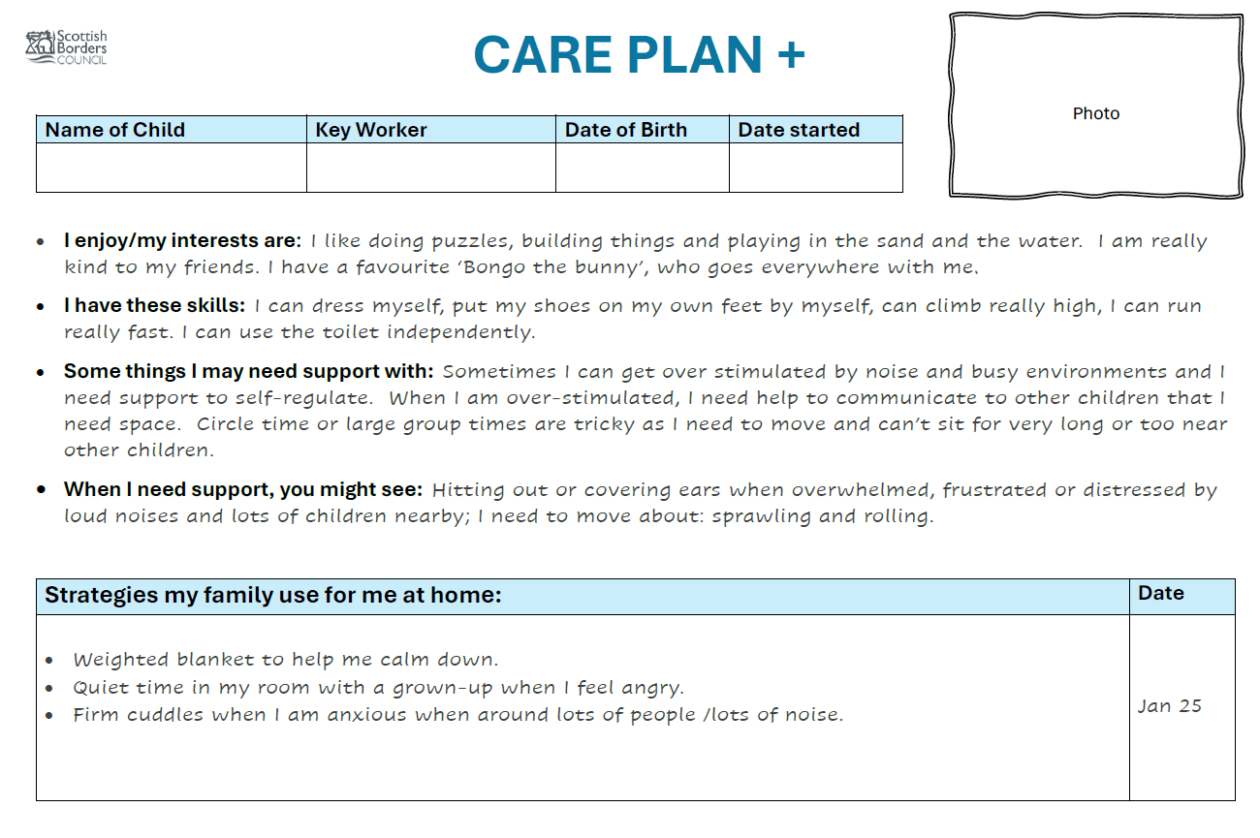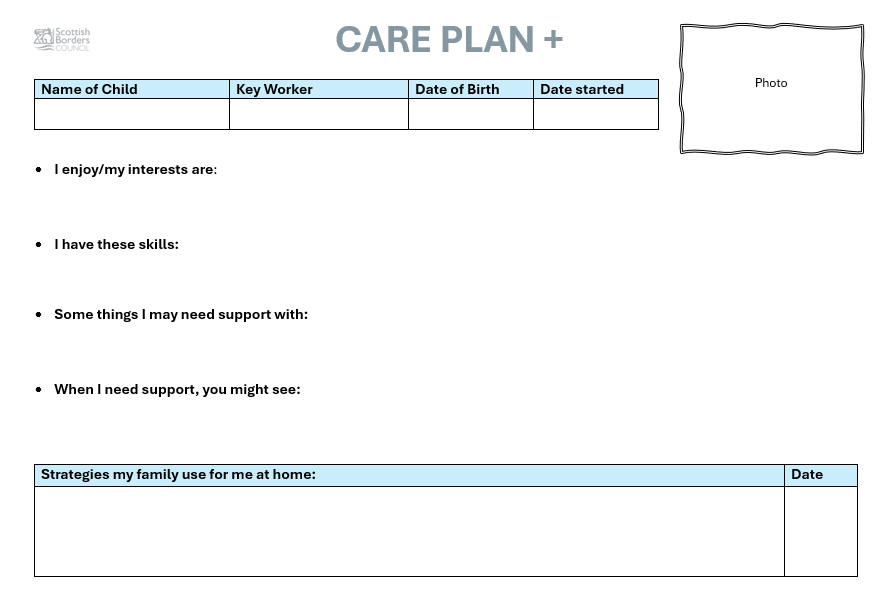- **New** SBC Care Plan (Version 2)
- Care Plan + EXAMPLE with Guidance
- Care Plan + (editable)
- Guidance for completing an SBC Care Plan +
 This new SBC Care Plan (v2) MUST be sent home with this Privacy Notice.
This new SBC Care Plan (v2) MUST be sent home with this Privacy Notice.
Effective immediately, the SBC Care Plan (Version 2) should be implemented for all new children and for any adaptations to current plans.
Please note that there is no requirement to replace existing Care Plans with this new version.
Example: Guidance for completing a Care Plan +
Guidance for completing a Care Plan +
Often in settings, we have children who need a more specific and considered approach to support their health and wellbeing. The Care Plan + was devised to support this.
This document should be created in consultation with parents/ carers or shared on completion in order for them to feed in if needed.
The approach used here is strengths based. Practitioners should identify any significant challenges the child is currently facing in ELC and use their interests and strengths to support them to overcome these challenges.
Practitioners should identify strategies to support the child develop skills that encourage a positive outcome in these situations.
All practitioners should read and discuss the strategies to ensure a consistent approach.
The above approach will encourage success, as with interactions based around interests and strengths, the child will feel heard and seen and with predictability, the child will feel safe.
Depending on the child, the length of time that the strategies are needed or are effective for will differ. For example, if the child is distressed by loud noises (and this is a sensory sensitivity) this plan will most likely be in place for longer than if the distress is leaving a parent as they transition into ELC.
The Care Plan + needs to be reviewed regularly for this reason.
If the strategies are ineffective then they should be reviewed and adapted to encourage success.
Guidance for completing an SBC Care Plan + (Individualised Support Plan)
Once a child has been identified as needing a Care Plan +:
The team should complete the Care Plan +:
- Discuss child’s interests and skills
- Plan focussed observations – at different times/days, ensuring it is factual
- Analyse observations – identify key strengths and needs of the child
- Agree areas they may need to support and behaviours displayed when needing support
- Identify possible strategies which could support child’s needs to ensure positive outcomes
- The plan should build skills step-by-step to improve success and give children and young people a chance to test strategies out and receive encouragement and feedback.
- Ensure strategies are clear, age and stage appropriate, manageable, which are respectful of the individual. Strategies may include additional guidance from allied professionals – e.g SaLT, OT, home support teacher.
- Ensure that all practitioners & parents/carers recognise potential stressors, such as changes in behaviour, mood, or relationships, of both children and staff, and then implement strategies to strengthen coping mechanisms and resilience.
- EYO &/or Key Worker work together with parents/carers to discuss the creation of the Care Plan + and above points
- Meet with any professionals currently involved (eg. Health visitor, pre-school home link worker etc.) to agree the creation of the Care Plan + and above points.
Holistic and consistent approaches are crucial for meeting all children’s needs and supporting positive outcomes.
Implementation
Once the document has been drafted it must then be shared, agreed and signed by all parties (ELC team, parents/carers and any other health professionals) and reviewed regularly.
- All practitioners should ensure consistent implementation within the setting. The plan must be available for all visiting staff, e.g. supply practitioners.
- Up-skill parents in how to use the key strategies at home, thus providing the child with a consistent approach from all adults e.g. giving them the same visual symbols to use at home / information around Keys to Communication, helpful links etc.
- Regularly check-in with parents should discuss the manageability and effectiveness of strategies being implemented at home.
- Bear in mind that the length of time that the strategies are needed for or are effective for, will differ depending on the needs of the child. For example, if the child is distressed by loud noises (and this is a sensory sensitivity) this plan will most likely be in place for longer than if the distress is leaving a parent as they transition into ELC.
- If the strategies are ineffective, they should be reviewed as needed and adapted to encourage success.
The review process
- Dates for revisiting and reflecting on the information must be planned, recorded in chronologies, or on the Quality Assurance Calendar – all parties should be aware of the review processes and reflect upon the efficacy of the intervention/ series of strategies in place.
- As this is a live document, changes can be made – minutes of the meeting should detail key points from the review and why changes are being made. It is best practice to minute all meetings – it may feel tedious, but this will ensure a clear record of the processes in place and the rationale for changes – which will support any further input / referral process.
- It is important to celebrate achievements, and strengths which the child is developing as part of the review process. The child should be aware of how they are developing in an appropriate way such as verbal praise and positive visual aids, – so that they are a part of the process and can see how the supportive strategies are helping them to be more engaged/ more regulated (UNCRC article 12)
- Ensure the whole team is aware of all information and any edits made and the rationale for the changes.
- During these reviews, strategies must be assessed, achievements noted and any developments must be updated on the revised Care Plan +. Staff should sign that they have read, agree new developments and a copy shared with parents.

